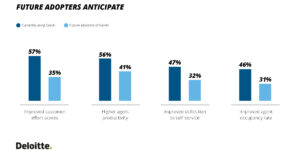The frequency of claims submitted for repairable electric vehicles (EVs) rose to its highest level in 2023, ending the year at 1.97 percent in the U.S. and 2.86 percent in Canada, according to the latest analysis by Mitchell, an Enlyte company.
The technology and information provider for the property/ casualty and collision repair industries announced the publication of its latest trends report: “Plugged-In: EV Collision Insights”.
The latest issue offers year-over-year analysis of EV claims volume, which increased in 2023 by more than 40 percent in the U.S. and Canada.
“2023 was a record year for electric vehicles,” said Ryan Mandell, Mitchell’s director of claims performance. “Not only did the frequency of EV collision claims rise to historic levels but the U.S. also surpassed 1.2 million in new EV sales for the first time ever. As long as consumer adoption remains strong, EVs will continue to have a significant impact on the auto insurance industry—creating challenges for everything from underwriting to the delivery of proper and safe repairs.”
In addition to tracking 2023 claims volume, the Mitchell report compares EVs to automobiles with an internal combustion engine (ICE), highlighting differences in severity, complexity and repairability.
Last year, average severity in the U.S. for repairable EVs was $6,018 compared to $4,696 for ICE alternatives, a difference of $1,322, representing a year-over-year decrease of 5 percent for EVs and an increase of 3 percent for ICE vehicles, Mitchell data showed.
In Canada, severity was $6,795 for EVs versus $5,122 for ICE-powered options, jumping 8 percent from 2022 to 2023.
For 2020 and newer collision-damaged automobiles, Mitchell found that EV repairs were 50 percent more likely to include an operation associated with the sensors used in advanced driver assistance systems (ADAS) based on 2023 data than ICE vehicle, though they also rely on ADAS.
EVs are more likely to use parts made of lightweight materials, which can impact the likelihood for repair,the technology provider said.
In 2023, on average only 12 percent of EV parts were repaired versus replaced. For ICE-powered options, the percentage of parts repaired was closer to 15 percent.
EVs tend to be heavier than ICE automobiles due to the battery weight. The report opines that may factor in to the higher frequency of airbag deployments (3.62 percent) than ICE options (2.45 percent) last year, adding to repair costs.
The publication also details the top North American regions and vehicle models associated with EV collision claims in 2023.





















 Lemonade Books Q1 Net Income Loss But Sees Progress
Lemonade Books Q1 Net Income Loss But Sees Progress  P/C Insurance Execs, Underwriters Out of Sync on Advanced Tech
P/C Insurance Execs, Underwriters Out of Sync on Advanced Tech  Study Finds Just 52% of Last Decade’s Largest Carrier M&As Created Long-Term Value
Study Finds Just 52% of Last Decade’s Largest Carrier M&As Created Long-Term Value  Growing Progressive Set to Hire 10,000+ in Claims, IT, Other Roles
Growing Progressive Set to Hire 10,000+ in Claims, IT, Other Roles 



